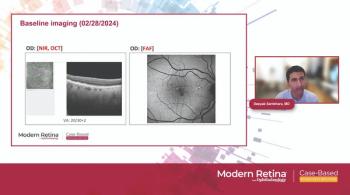
A new technique to estimate melanocytic choroidal tumor thicknesses without B-scan ultrasonography
Stanford University researchers from the Ocular Oncology Service of the Byers Eye Institute, and the Department of Radiation Oncology, Palo Alto, CA, proposed that melanocytic tumor thicknesses in the choroid may be rapidly and reliably approximated by ultra-widefield (UWF) green-channel (GC) images (Optomap) without using B-scan ultrasonography,1 according to Michael D. Yu, MD.
The tumor thickness is a well-established risk factor for malignant transformation of choroidal nevi into melanoma, the authors explained. Up to now, however, establishing reliable tumor thicknesses of melanocytic choroidal lesions has required B-scan ultrasonography, a technology that is not always readily available.
The authors conducted a retrospective, cross-sectional study in which they described a technique for estimating the melanocytic choroidal tumor thickness using only Optomap UWF images. They did this by investigating a correlation between choroidal tumor thicknesses on B-scan ultrasonography images and the pixel intensity of the tumors on GC UWF images. The main outcomes were the correlation between ultrasonographic tumor thickness and pixel intensity difference (PID) and the sensitivity and specificity of the regression analysis trendline in estimating tumor thickness, Yu and colleagues recounted.
Significance of the PID
The data from 138 patients (mean age, 57 years) were included, 125 of whom had nevi and 13 melanoma. The tumors were of varying thicknesses.
Yu and colleagues reported that the mean ultrasonographic tumor thickness was 1.1 mm (median, 0.8 mm; range, 0.2-5.5 mm), and the mean PID was 2.13. When the lesions were stratified by the thicknesses seen on B-scan ultrasonography (<1.0 mm vs 1.0-2.0 mm vs >2.0 mm), they found that the mean PID increased (−1.95 vs 3.72 vs 17.62; P < .001) as the mean thickness of the tumors increased (0.5 mm vs 1.4 mm vs 3.3 mm; P < .001). “The PID was correlated with tumor thickness (R2 = 0.823; 95% CI, 0.770-0.875; P < .001) across lesions of all sizes,” the authors reported.
The investigators concluded that this technique can potentially provide reliable and rapid estimation of tumor thickness using UWF Optomap images without the need for B-scan ultrasonography.
Reference
Yu MD, Heiferman M, Korot E, et al. Pixel intensity to estimate choroidal tumor thickness using 2-dimensional ultra-widefield images. JAMA Ophthalmol. JAMA Ophthalmol. 2025;Published online February 6; doi:10.1001/jamaophthalmol.2024.6064
Newsletter
Keep your retina practice on the forefront—subscribe for expert analysis and emerging trends in retinal disease management.








































